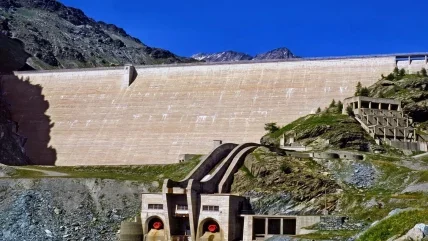
On the Isle of Rum, off Scotland’s west coast, electricity has been generated from hydropower since the start of the 20th Century. Originally serving the then newly built Kinloch Castle, an ostentatious home of the industrialist Bullough family, the Kinloch Hydro scheme is now owned and operated by NatureScot, Scotland’s nature agency, and supplies not only the castle but also the rest of the island community in and around Kinloch village. Gilkes supplied a 15kW Pelton turbine in 1946 to replace the original machine and a subsequent 30kW Pelton in 1984 when NatureScot undertook a major refurbishment of the hydro scheme.
The powerhouse for the two machines sits in the castle grounds and is connected to an island mini grid with its own distribution system, providing vital power for the remote local community. The Isle of Rum is a National Nature Reserve and a Special Area of Conservation and the use of hydropower as a source of renewable energy reduces the island’s reliance on diesel power generation, helping to reduce environmental impact and contributing to the pursuit of net zero.
Although the scheme is currently owned and managed by NatureScot, there is a joint aspiration with the community, members of which are employed to help with daily checks, for the creation of a community energy company, or similar such entity, which could take over the ownership and running of Rum’s power generation and distribution in the future.
Gilkes undertake regular maintenance of the hydropower equipment at Kinloch and are currently working with NatureScot to understand the potential for increased generation as demand on the island grows. Further modernisation of the scheme and upgrade of various components with modern technology has the potential to improve performance, functionality and increase generation.
Gilkes has also worked on Kaptega Hydro in Kenya. Mount Elgon Orchards Ltd is a remote farm based on the Kenya and Uganda border, exporting 80 million top quality roses around the world. The family farm also grows 80 hectares of avocados and is the largest employer in Trans Nzoia (Western Kenya) employing 1400 permanent employees. Its corporate social responsibility is also impressive, with three schools for 2000 children, medical facilities treating 40,000 patients annually, a children’s home, a special needs home, a physiotherapy centre, and an orthopaedic workshop.
The Kaptega hydro plant was commissioned in 2018 and with Gilkes’ 13.5” Twin Jet Turgo turbine it produces 249kW, saving the farm over 1100 litres of diesel per day, previously in its diesel generators.
The electrical characteristics of the site were unusual and demanding, requiring black start ability, islanded running, and regular load changes of up to 50kW. With the potential of a future grid connection, this scheme had to be engineered for changing needs. As with many Gilkes turbines, the powerhouse will be unmanned and require only routine inspection and maintenance. The simplicity of the Turgo impulse operation translates to minimal service and maintenance requirements, making it particularly suited to remote, rural, electrification schemes such as Kaptega.
Andy Eaton, Head of Sales for Hydro at Gilkes, says that both of these projects demonstrate the vital role small hydropower can play in providing sustainable, clean energy to remote communities. Small hydropower in particular is environmentally and socially responsible. Scalable installations for any landscape or location provide a short return on investment with a long asset life.
Having worked in the global hydropower industry for over 30 years, Eaton believes a vital key to the future of the industry is collaboration and sharing of knowledge. By working together, developers, consultants, equipment suppliers etc can spread an understanding of the technology and varied applications where hydropower can be installed. Globally there is also an increasing need to modernise and optimise existing installations to maintain the lifespan and increase generation.
Education of policy makers is also key to putting hydro on a level with other renewables.
“In our industry, which is small hydro, it is very satisfying to give rural communities power that they have never had before,” Eaton said. “When these schemes are being constructed, local people are employed, alongside the building of infrastructures such as schools and hospitals. Quick to develop, with little impact on the environment a lot of a little can have a significant impact on the fight against climate change.”






